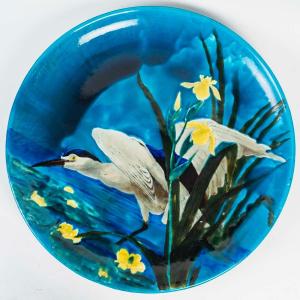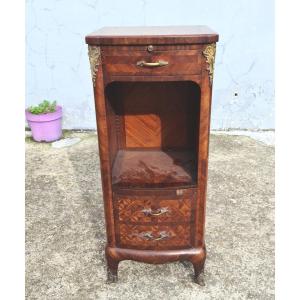René Lalique (1860-1945)
Flared "Piriac" model vase in molded pressed deeply opalescent glass
Decorated with a frieze of fish and wavy lines
Signed "R.Lalique France"
Model created in 1930
H: 18 cm
Bibliography:
Catalogue Raisonné of the work of R.Lalique by Félix Marcilhac
Illustrated page 447 under N ° 1043
René Jules Lalique, master glassmaker and French jeweller, born on April 6, 1860 in Ay (Marne) - Died on May 5, 1945.
He studied drawing and goldsmithing at the School of Decorative Arts in Paris.
He works for renowned jewelers such as Boucheron, Vever and Cartier.
From 1878 to 1880 he attended Sydenham Art College in London.
In 1882, he became an independent designer for several jewelry houses in Paris and four years later launched his own jewelry.
In 1890, Lalique is recognized as one of the most important jewelry designers of French Art Nouveau, creating innovative pieces for the new boutique of Sa-muel Bing in Paris, «La Maison de l'Art Nouveau»
He participated in the 1900 Universal Exhibition in Paris, which established an international reputation for him.
While keeping the sources of inspiration of Art Nouveau, fauna and flora, including peacock and insects.
He innovates by using materials little used for jewelry at that time: glass, enamel, leather, horn, mother of pearl.
After opening a boutique place Vendôme in Paris, he began to design glass perfume bottles.
He also does so in order to produce beautiful objects in important series, and therefore to make his art accessible to a growing number of people.
Vases, cups, dishes, perfume bottles, emblems of major car brands, or panels (such as those that will decorate the dining room of the Normandy liner) are produced in series according to new techniques such as colored glass, opalescent, frosted, engraved or speckled.
In 1920, he turned to Art Deco.
It also creates aesthetic effects: Lalique satin, opalescent glasses and also has sinuous fabrics, fans and ironwork pieces.
He had his own pavilion at the Paris Decorative Arts Exhibition in 1925 where he applied the many resources offered by glass to decoration (fountains, lighting, doors).
The factory in Alsace, closed during the war, was reopened by his son Marc in 1946 after the death of his father.








































 Le Magazine de PROANTIC
Le Magazine de PROANTIC TRÉSORS Magazine
TRÉSORS Magazine Rivista Artiquariato
Rivista Artiquariato